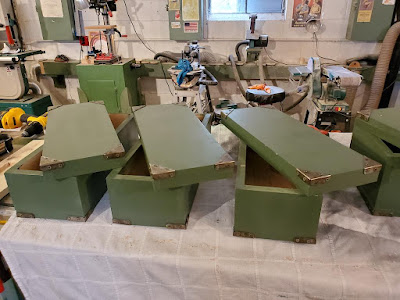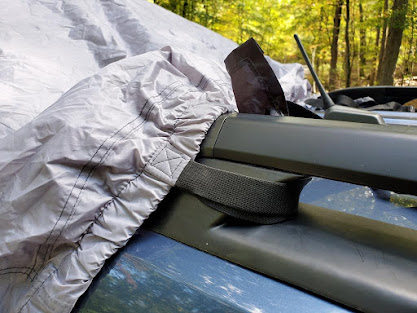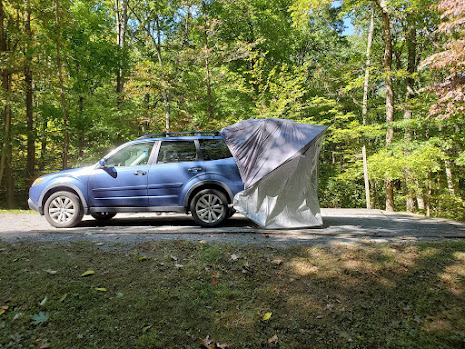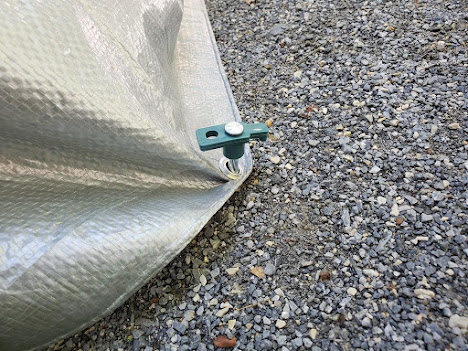Mannie Gentile: Camping with the Old Ranger
Happily retired.
So anyway...where was I?
oh yeah...In May of 2020, I pulled the plug on my career with the National Park Service and I put in my papers to retire.
My plan was to take a year to exuberantly goof-off; which I did. Then I started two things that I had been dreaming about for years:
1. Go back to college to get a degree in visual arts
2. Get back to camping (after a decades-long hiatus).
Last week, I finished my first semester, and last autumn (2020) I got back in to the woods.
I'm right on track.
Mannie
(the old ranger)
Recon
So anyway... where was I?
oh yeah,...I'm taking delivery on a little square-drop camper in the spring (covid permitting) and I've been scouting out potential campsites at good old Greenbrier State Park. It's going to be a long, ten-minute, pull to the park, but I think I'm up to it.

Mini-trailer/camper camping is making me look at campsites differently. My two favorite spots at Greenbrier are difficult to back in to - even without a trailer. So I need to find sites that will be a little easier to get in to.
Last weekend, I took advantage of an unseasonably mild day, to hike around two of the four camping loops to find suitable sites.
I've found a few pull-through spots and also one with a wide-enough entry to make backing a trailer easier, it has some nice elevation, a good enough sun/shade mix to to charge up the solar generator, and, most importantly, no nearby neighbors.
We'll see how this pans out
Hey, did I mention that I'm a retired Park Ranger?
I'll be back.
Mannie
(the old ranger)
So anyway...where was I?
Oh yeah...camping.
In 1975, a year after I got out of the US Navy, I began camping, and before too long I was an avid camper. I went out to the woods of Michigan at least three times every season, and made many camping trips in Pennsylvania as well as Tennessee. I loved it. I once went camping all around Lake Superior...the "circle route"; up through Michigan to Ontario, Minnesota, Wisconsin, and back to Michigan.
I especially liked camping with my good friends Pete and Kim; together we explored many of the beautiful Great Lakes parks and woodlands of Michigan. My dear friend Linda Sweigart and her niece Stacy, and I made a memorable trip to Manitou Island in northern Lake Michigan. I spent a lot of time in a tent in the wilds of the Upper Peninsula of Michigan, Camping in Michigan is incredible, the influence of the towering native white pine and the Great Lakes are everywhere. People who aren't from Michigan would weep with envy if they could see Ludington State Park on Lake Michigan, De Tour State Park on Lake Huron, Hartwick Pines State Park - spared the axe in the heyday of Michigan's dominion of the timber industry, P.J. Hoffmaster, Mackinac Island, Sleeping Bear Dunes...the list goes on; 74 state parks and 12 state forests.
This is the wonderland that I had at my fingertips.
Changing circumstances being what they were, twenty-five years, or so, ago, I fell out of camping, It wasn't convenient for a variety of reasons. I did, however have a used 22-footer RV for about four years, and that thing was a joy...but maintenance was becoming an issue so I sold it while I could still get a good price. But, generally, I was out of the woods.
As time marched on, I found myself in a position to take up my old hobby again. It was almost exactly six years ago that I took another stab at it.
I started afresh, with new gear, including a luxurious Coleman eight-person tent! What comfort, what headroom, what a delight to have a screened-in vestibule as part of the tent...
what a pain to erect. Literally, what a pain. I think that I pulled every muscle of every muscle I have putting that thing up. After practicing in the backyard, I packed up everything and drove to nearby Greenbrier State Park here in Maryland. The hassle of erecting the tent, the discomfort of sleeping on the ground, and a general aimlessness turned it into a pretty hollow experience...so, again, I moved away from camping.
But still...
I love Greenbrier. When I still lived in Michigan I would drive twelve hours to get to Greenbrier, smack in Civil War country, which was, and still is, one of my enduring interests. But after a twelve-hour drive, by the time I got to the park, I was exhausted...and I still had to get the tent up.
Well Greenbrier is still my favorite Maryland Park, and now I have to drive...
9 minutes to get there.
You can't beat that.
What has gotten me back in to the woods is the concept of "car camping" and a screened-in hatch awning for my Subaru Forrester.
I've been doing post-season and pre-season camping for the past since autumn of 2020 and I'll be out again this coming spring (by which time I hope to have a small "square-drop" trailer). Each jaunt is a two-night adventure. And I have been enjoying it immensely. The cooking, the solitude, and evening campfire, listening to my solar-powered radio, and sleeping in the semi-bear proof safety of my car, snug as a bug in my own personal Gemini capsule. I'm so happy to be back in the woods, and how it conjures up good memories of Pete, Kim, Linda, Stacey and others.
I promised some like-minded friends that I would post some pictures of how to set it up. What follows is a step-by-step primer on how to erect the Napier hatch awning...and it's also a great way to kick off this blog.
So...on we go!
When sliding the sleeve-like awning over the lid of the hatch there are two reenforced corners that the corners of the hatch lid fit into.
It's pretty ironic that now that I'm no longer a Park Ranger, I'm spending a lot more time in nature.See you out there.Mannie
(the Old Ranger)
So anyway...where was I? Back when I was camping the first time (late 1970s), my wife, of that time, did all the packing. It was a chaotic ...

-
So anyway...where was I? oh yeah...In May of 2020, I pulled the plug on my career with the National Park Service and I put in my papers to r...
-
So anyway...where was I? Back when I was camping the first time (late 1970s), my wife, of that time, did all the packing. It was a chaotic ...
-
So anyway... where was I? oh yeah,...I'm taking delivery on a little square-drop camper in the spring (covid permitting) and I've b...














































